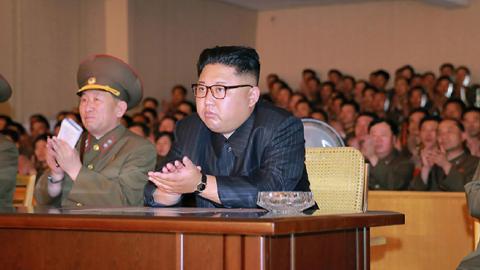Since North Korean leader Kim Jong Un appears to have backed away from his threat to fire missiles toward the U.S. Pacific territory of Guam, the international crisis building on the Korean peninsula has eased a bit -- for now.
All the same, American intelligence agencies still believe North Korea now has the ability to miniaturize nuclear weapons to fit on a ballistic missile, and will have a missile ready to reach the U.S. mainland within a year.
It’s an ugly reminder that North Korea’s missile and nuclear programs are not only the most urgent threat to peace the world faces today, but that the timeline for dealing with them grows steadily shorter.
Fortunately, there’s an alternative to either preemptive military action such as air strikes, which could plunge the region into a catastrophic war, or resigning ourselves to a North Korea armed with ballistic nuclear missiles.
A Hudson Institute conference held in San Diego last month proposed a new approach backed by existing technology, one that can halt Kim’s missiles almost as soon as they leave the launching pad.
The first step would be for the United States to create a “no-launch zone” over North Korea. It would declare that any and all missile launches from North Korean territory will be deemed an immediate threat to regional peace and security, and will be shot down before the missile leaves North Korean air space.
The second step is to implement a program that intercepts Kim’s missiles in their initial boost phase.
Every large, multistage rocket needs high-thrust booster engines to get out of the atmosphere, boosters that drop away as the missile achieves orbit.
Killing a missile at this early boost phase has all kinds of advantages. Since it’s the red-hottest stage of a ballistic missile launch, it’s the easiest for long-range infrared sensors to detect and identify.
It’s also the slowest phase of the launch. A missile in later phases of the launch, such as the terminal phase, gains speed as it closes on its target.
Existing terminal-phase missile interceptors -- such as Terminal High Altitude Area Defense, the so-called THAAD missile shield being employed in South Korea, and the Aegis detection system on U.S. Navy ships -- can’t do boost-phase interception, because they can’t detect the launch soon enough.
The U.S. Missile Defense Agency is working on a boost-phase intercept system using high-energy lasers, but it admits it’ll take years to implement.
Congress is pushing for a boost-phase intercept system based in space, but that will take even longer and be even more costly.
A more efficient solution is at hand using unmanned aerial vehicles, or drones.
There are already American-built unmanned vehicles capable of detecting a North Korean missile in boost phase and destroying it with up to four interceptor missiles carried aboard the drone.
The unmanned aircraft could accomplish that while being stationed hundreds of miles off the North Korean coast, in international air space at an altitude of 45,000 to 55,000 feet.
Conventional fighter aircraft have successfully done boost-phase intercept tests using missiles of this type.
Putting those missiles on a rotating drone patrol off the North Korean coast would provide a vital frontline layer of security against missile attack -- while also ensuring that any debris from an intercepted missile falls onto North Korean territory, or into the Sea of Japan.
First proposed by Leonard Caveny, former science and technology director of the Ballistic Missile Defense Organization, the idea of high-altitude, long-endurance boost-phase interception was the subject of July’s Hudson Institute conference in San Diego.
The conference was held at General Atomics Aeronautical, a San Diego-based company that produces unmanned aerial vehicles that could be used in this defense scenario. (Full disclosure: Linden Blue, General Atomics Aeronautical chief executive, is on the Hudson Institute board.)
Keynote speakers were the former chairman of the House Armed Services Committee, retired U.S. Rep. Duncan L. Hunter, and former Japanese Defense Minister Itsunoru Onodera, who was reappointed to that post less than a week later.
The conference brought together Japanese and American engineers and executives and experts to examine the data and consider the options.
Their verdict was unanimous: high-altitude, long-endurance boost-phase interception using conventional missiles was not only technically feasible – it is the best short-to-midterm solution to stopping North Korean missile launches.
Moreover, the intercept missile’s 3.5 to 3.7 kilometer-per-second velocity would give the system’s on-the-ground operators nearly a minute to decide whether to intercept -- plenty of time to initiate the kill chain.
Since all the technology involved has already been tested, Caveny’s original timeline for a working prototype was two years.
However, with the U.S. and Japan working together on a fast-track development and deployment schedule, that timeline could shrink to a year or less -- and at a cost that’s a fraction of THAAD’s $800 million to $1 billion price tag.
No ballistic missile system is ever foolproof. That’s why THAAD and Aegis are still necessary to protect regional allies like Japan and South Korea -- and why development of a laser boost-phase intercept system should still press ahead.
But boost-phase interception from drones will add a vital and timely layer of protection both for U.S. and for Japan.
And, a no-launch policy serves notice on Pyongyang and its patron, Beijing: America and its allies will never permit nuclear blackmail, and are ready to deploy the technology needed to stop that threat cold.



















